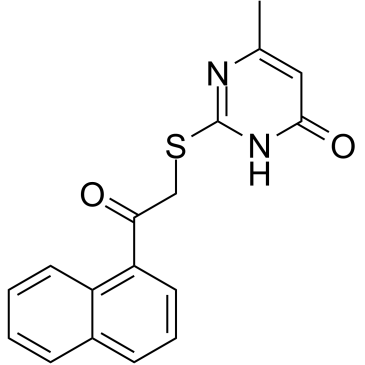| In Vitro |
I3MT-3 (1 μM) is selective for 3MST and shows a high inhibitory activity (80–90%) even at 10 μM in cell lysate of 3MST-overexpressing HEK293 cells. Besides, it is almost inactive towards the other two H2S-producing enzymes even at 100 μM[1]. I3MT-3 (1 μM) shows a high selectivity for 3MST, it completely suppresses the 3MST activity in COS7 cells living cells[1]. I3MT-3 produces a concentration-dependent inhibition of the AzMC (the fluorescent H2S probe) signal when incubated with purified human recombinant enzyme, the inhibition of the catalytic activity of 3-MST produces a concentration-dependent inhibition of H2S production with an IC50 of 13.6 µM[1]. I3MT-3 shows a dose-dependent inhibition of 3-MST activity from CT26 homogenates, which contain the murine form of the enzyme. The IC50 of HMPSNE for murine 3-MST is calculated as 2.3 µM with a cozncentration-dependent decrease of AzMC fluorescence[1]. I3MT-3 (10 µM-100 µM; after 3 h probe AzMC) causes a partial inhibition of the signal, while at 100 µM, HMPSNE causes a complete inhibition of the AzMC-guided H2S fluorescence at 100 µM, Additionally, HMPSNE is capable of inhibiting its target in situ in CT26 cells (with an IC50 of approximately 30 µM)[2]. I3MT-3 (0-300 μM; 5-50 hours) does not enhance MTT conversion at 10 µM, while at 100 and 300 µM it produces an inhibitory response, without increasing the LDH signal, i.e., without inducing any detectable degree of cell necrosis. It also produces a decreased oxygen consumption rate (OCR) profiles in CT26 cells[2]. I3MT-3 (0-300 μM; 48 hours) inhibits CT26 cells proliferate with increasing concentrations of I3MT-3. Confluence of cells treated with HMPSNE is recorded each hour for 48 h by the IncuCyte method[2]. Cell Proliferation Assay[2] Cell Line: CT26 cells Concentration: 0 μM; 10 μM; 30 μM; 100 μM; 300 μM Incubation Time: 48 hours Result: Slowed down proliferation of CT26 cells.
|
